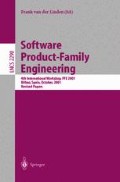Abstract
Although software mass customization offers the potential for order-of-magnitude improvements in software engineering performance, the up-front cost, level of effort, assumed risk, and latency required to make the transition to software mass customization are a prohibitive adoption barrier for many organizations that could otherwise benefit. BigLever Software has developed a software mass customization technology that lowers the adoption barrier, enabling software organizations to achieve the benefits of software mass customization with significantly less transition time and effort. This technology supports three different transition models for adopting software mass customization.
Access this chapter
Tax calculation will be finalised at checkout
Purchases are for personal use only
Preview
Unable to display preview. Download preview PDF.
References
Software Engineering Institute. The Product Line Practice (PLP) Initiative, Carnegie Mellon University, http://www.sei.cmu.edu/activities/plp/plp_init.html
Weiss, D., Lai, R. 1999. Software Product-line Engineering. Addison-Wesley, Reading, MA.
Bass, L., Clements, P., and Kazman, R. 1998. Software Architecture in Practice. Addison-Wesley, Reading, MA.
Jacobson, I., Gris, M., Jonsson, P. 1997. Software Reuse: Architecture, Process and Organization for Business Success, ACM Press / Addison-Wesley, New York, NY.
Clements, P., Northrop, L. 2001. Software Product Lines: Practice and Patterns, Addison-Wesley, Reading, MA.
Krueger, C. Using Separation of Concerns to Simplify Software Product Family Engineering. April 2001. Proceedings of the Dagstuhl Seminar No. 01161: Product Family Development. Wadern, Germany.
Krueger, C. Software Reuse. 1992. ACM Computing Surveys. 24, 2 (June), 131–183.
Krueger, C. 1997. Modeling and Simulating a Software Architecture Design Space. Ph.D. thesis. CMU-CS-97-158, Carnegie Mellon University, Pittsburgh, PA.
Author information
Authors and Affiliations
Editor information
Editors and Affiliations
Rights and permissions
Copyright information
© 2002 Springer-Verlag Berlin Heidelberg
About this paper
Cite this paper
Krueger, C. (2002). Easing the Transition to Software Mass Customization. In: van der Linden, F. (eds) Software Product-Family Engineering. PFE 2001. Lecture Notes in Computer Science, vol 2290. Springer, Berlin, Heidelberg. https://doi.org/10.1007/3-540-47833-7_25
Download citation
DOI: https://doi.org/10.1007/3-540-47833-7_25
Published:
Publisher Name: Springer, Berlin, Heidelberg
Print ISBN: 978-3-540-43659-1
Online ISBN: 978-3-540-47833-1
eBook Packages: Springer Book Archive

